

Voyant Tools. StatWiki. Lesson 12: Factor Analysis. Factor Analysis is a method for modeling observed variables, and their covariance structure, in terms of a smaller number of underlying unobservable (latent) “factors.”
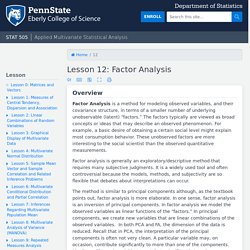
The factors typically are viewed as broad concepts or ideas that may describe an observed phenomenon. For example, a basic desire of obtaining a certain social level might explain most consumption behavior. These unobserved factors are more interesting to the social scientist than the observed quantitative measurements.
Factor analysis is generally an exploratory/descriptive method that requires many subjective judgments. It is a widely used tool and often controversial because the models, methods, and subjectivity are so flexible that debates about interpretations can occur. The method is similar to principal components although, as the textbook points out, factor analysis is more elaborate. Forums. Effect Size Calculator. Indexes (list) - WikiofScience. Mike Cox - Research Methods and Skills II - PSY1011. Counterfactual Theories of Causation.
1.
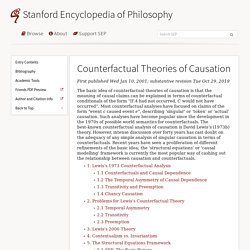
Early Counterfactual Theories The first explicit definition of causation in terms of counterfactuals was, surprisingly enough, given by Hume, when he wrote: “We may define a cause to be an object followed by another, and where all the objects, similar to the first, are followed by objects similar to the second. Or, in other words, where, if the first object had not been, the second never had existed.” (1748, Section VII).
It is difficult to understand how Hume could have confused the first, regularity definition with the second, very different counterfactual definition. At any rate, Hume never explored the alternative counterfactual approach to causation. Indeed, the first real attempts to present rigorous counterfactual analyses of causation came only in the late 1960's. The true potential of the counterfactual approach to causation did not become clear until counterfactuals became better understood through the development of possible world semantics in the early 1970's. NOTES - UCLA 81st FACULTY RESEARCH LECTURE SERIES.
CAUSALITY, 2nd Edition, 2009. HyperStat Online: An Introductory Statistics Textbook and Discussion of whether most published research is false. Recommend HyperStat to your friends on Facebook Click here for more cartoons by Ben Shabad.
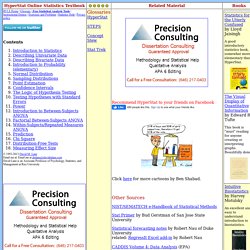
Other Sources NIST/SEMATECH e-Handbook of Statistical Methods Stat Primer by Bud Gerstman of San Jose State University Statistical forecasting notes by Robert Nau of Duke University related: RegressIt Excel add-in by Robert Nau CADDIS Volume 4: Data Analysis (EPA) The little handbook of statistical practice by Gerard E. Stat Trek Tutorial. Ciencia sin seso… locura doble - Píldoras sobre medicina basada en pruebas.
Responsible Science - NCBI Bookshelf. Scientific Principles and Research Practices - Responsible Science - NCBI Bookshelf. Philosophical Transactions of the Royal Society of London. PLOS Medicine: A Peer-Reviewed Open-Access Journal. Calling Bullshit — Syllabus. Logistics Course: INFO 198 / BIOL 106B.
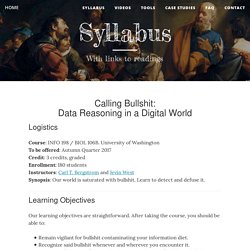
University of Washington To be offered: Autumn Quarter 2017 Credit: 3 credits, graded Enrollment: 180 students Instructors: Carl T. Bergstrom and Jevin West Synopsis: Our world is saturated with bullshit. Learn to detect and defuse it. Learning Objectives Our learning objectives are straightforward. Remain vigilant for bullshit contaminating your information diet. We will be astonished if these skills do not turn out to be among the most useful and most broadly applicable of those that you acquire during the course of your college education.
Schedule and readings Each of the lectures will explore one specific facet of bullshit. Lectures Week 1. Harry Frankfurt (1986) On Bullshit. Supplementary readings Week 2. Week 3. Gordon Pennycook et al. (2015) On the reception and detection of pseudo-profound bullshit. Week 4. Supplementary reading. Exploratory Factor Analysis: A book manuscript by Ledyard. From 1987 until about 1993, Ledyard Tucker and I worked on writing a book on factor analysis.
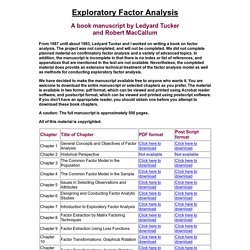
The project was not completed, and will not be completed. We did not complete planned material on confirmatory factor analysis and a variety of advanced topics. In addition, the manuscript is incomplete in that there is no index or list of references, and appendices that are mentioned in the text are not available. Nevertheless, the completed material does provide an extensive technical treatment of the factor analysis model as well as methods for conducting exploratory factor analysis. We have decided to make the manuscript available free to anyone who wants it. A caution: The full manuscript is approximately 500 pages. Causal and Statistical Reasoning. SAS/STAT User's Guide. The Psychometrics Centre. Muthén & Muthén, Mplus Home Page. StatWiki.